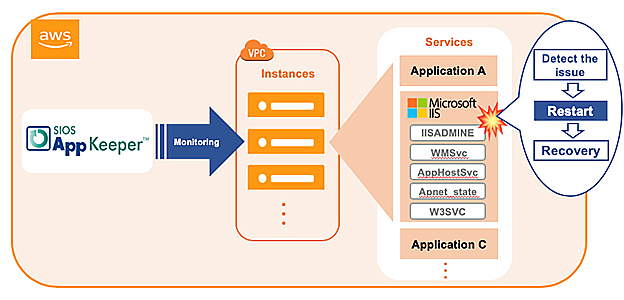Automated Recovery For Microsoft IIS Applications Running on Amazon EC2
A Better Choice For Reducing IIS Downtime
Microsoft’s IIS (Internet Information Services) is the fourth most popular web server in use today, with a 7.8% market share behind Apache, Nginx, and Cloudflare (source W3Techs.com, 8/12/20). And many IIS customers are running their IIS applications on Amazon EC2.
IIS is a versatile, extensible, and highly configurable web server. IIS includes some important functionality to ensure that applications are running properly, such as Application Pools and remote management capabilities to allow administrators to manage IIS remotely using PowerShell.
Deciding How To Monitor And Manage IIS Applications
When it comes to managing and monitoring IIS applications, customers have a number of options. They are either focused on improving the performance of applications running on IIS, or monitoring and addressing any failures.
Microsoft does include some native functionality to help you optimize and manage your applications running on IIS. If you and your team are very technical, then you may be comfortable using PowerShell or another scripting language to manage IIS Application Pools. Doing this allows you to automatically recycle your pools and virtual memory when certain time or request thresholds are met.
But this does not help you if your IIS applications experience a failure. To monitor your IIS servers, you need to look to monitoring (“APM”) tools that can alert you to any failures and provide you with details about what failed. These include commercial solutions such as from SolarWinds, AppDynamics, Dynatrace, Datadog, and New Relic. How you decide between them depends on your requirements, the scope and sophistication of their features, and the user interface and the simplicity of the set-up process. APM solutions are great at alerting you when something goes wrong and why, but they don’t always help you get back up and running if your IIS servers are down.
A Better Choice For Reducing IIS Downtime
If you are looking for a solution that not only monitors your IIS servers running on Amazon EC2 but also eliminates downtime, then we encourage you to check out SIOS AppKeeper monitoring solutions. AppKeeper continuously monitors and automatically recovers applications, such as those running on IIS, if they experience service interruptions and downtime.
Let’s look at how AppKeeper EC2 monitoring solution helps reduce IIS downtime:
- AppKeeper monitors your EC2 services and instances. Once you install and configure AppKeeper (which only takes about 10 minutes) you specify which Amazon EC2 instances and services it should monitor, and what actions should be taken if a systems impairment is experienced.
- AppKeeper alerts you if any systems failures are detected with your IIS webservers. You receive an alert by email or SMS and can see the details of the failure events and what actions were taken.

- AppKeeper lauches automatic restarting services and rebooting instances if necessary upon the detection of system failures. You no longer have to respond to any alerts and troubleshoot what happened before restarting. AppKeeper does that automatically for you.
By going beyond simply managing IIS server performance or monitoring to automatic remediation, AppKeeper eliminates downtime and provides the peace of mind you deserve.
Today hundreds of companies rely on AppKeeper to keep their cloud environments running. We invite you to check out the video below see how easy it is to install and use AppKeeper.
Video: Installing AppKeeper and recovering from AWS EC2 failures Demo
And if you like what you see, please feel free to sign up for a free 14-day trial of AppKeeper.
Reproduced with permission from SIOS

